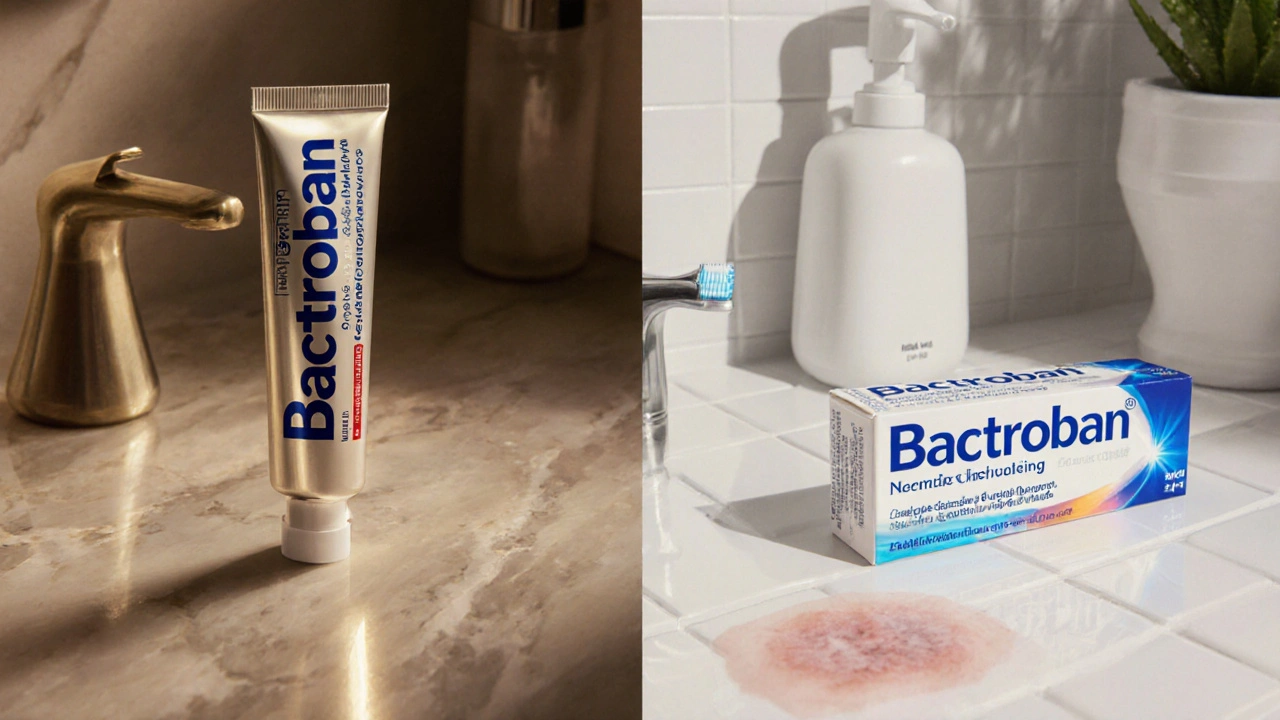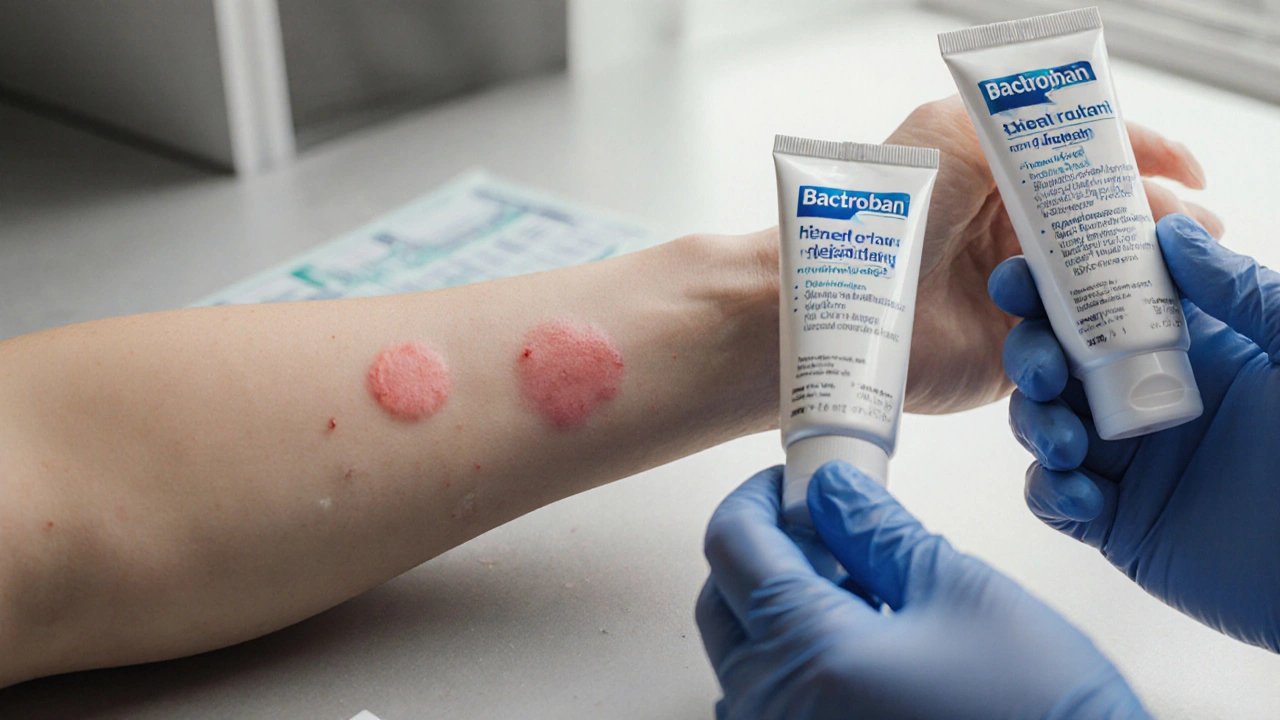Topical Antibiotic Selector
Select your symptoms and preferences to find the best antibiotic ointment for your skin condition.
Mupirocin alternatives are on many people’s minds when they need a reliable cream for skin infections. Below is a quick snapshot so you can see where Bactroban stands among the most common options.
- Broad‑spectrum coverage against Staphylococcus aureus and Streptococcus pyogenes
- Prescription‑only in the UK, typically priced £4‑£6 for a 5g tube
- Low resistance risk compared with older antibiotics
- Alternative ointments may be cheaper but have narrower activity or higher irritation rates
- Choosing the right product depends on infection type, skin sensitivity, and cost considerations
What is Bactroban (Mupirocin) exactly?
When you first see the name Bactroban is a topical antibiotic containing mupirocin, a natural product derived from Pseudomonas fluorescens. It works by blocking bacterial protein synthesis, which stops the bacteria from growing. In the UK it’s sold in a 5g tube and is the go‑to choice for localized infections like impetigo, small ulcerations, and infected cuts.
How does it compare to other creams?
We’ll look at the most frequently used alternatives and line them up against Bactroban on the criteria that matter most to patients and clinicians.
Key comparison criteria
- Active ingredient - the molecule that does the killing
- Antibacterial spectrum - which bugs it covers
- Typical indications - what skin problems it’s meant for
- Prescription status - over‑the‑counter (OTC) or prescription only
- Cost (UK) - average retail price for a 5g tube
- Side‑effect profile - common irritation or allergic reactions
Side‑by‑side comparison table
| Product | Active ingredient | Spectrum | Typical use | Prescription? | Average UK price (5g) | Common side effects |
|---|---|---|---|---|---|---|
| Bactroban | Mupirocin | Gram‑positive (incl. MRSA), some Gram‑negative | Impetigo, minor wounds, folliculitis | Prescription | £4‑£6 | Mild burning, itching |
| Fusidic acid cream | Fusidic acid | Gram‑positive (mainly Staphylococcus) | Impetigo, infected eczema | Prescription (some OTC 2% in Scotland) | £2‑£4 | Rash, stinging |
| Bacitracin ointment | Bacitracin | Gram‑positive (limited MRSA coverage) | Minor cuts, abrasions | OTC | £1‑£2 | Allergic contact dermatitis |
| Neomycin/Polymyxin B (Triple‑antibiotic) | Neomycin + Polymyxin B + Bacitracin | Broad Gram‑positive/negative (excluding Pseudomonas) | Minor wounds, burns | OTC | £1‑£3 | Allergy, redness |
| Retapamulin ointment | Retapamulin | Gram‑positive (incl. MRSA) | Impetigo, superficial infections | Prescription | £7‑£9 | Burning, itching |
| Clindamycin gel | Clindamycin phosphate | Gram‑positive, anaerobes | Acne, infected follicles | Prescription | £5‑£8 | Dryness, irritation |
| Tea tree oil (5% cream) | Melaleuca alternifolia oil | Broad, but weaker against MRSA | Minor infections, acne | OTC | £3‑£5 | Sensitisation, skin dryness |
| Silver sulfadiazine cream | Silver sulfadiazine | Broad (including Pseudomonas) | Burn wounds, larger ulcers | Prescription | £6‑£9 | Discoloration, local irritation |

When is Bactroban the right pick?
Because mupirocin hits both MRSA and ordinary Staph species, it’s the safest bet for stubborn impetigo or any infection where you suspect resistant bacteria. If you’re treating a simple scrape that isn’t infected, an OTC option like bacitracin may be enough and will save you a pharmacy visit.
Safety and tolerability
Most users experience only mild burning or itching that fades within a day. Rarely, people develop contact dermatitis-especially if they’ve used other topical antibiotics before. Those with a history of sulfa allergy should steer clear of silver sulfadiazine, but it isn’t an issue for mupirocin.
Cost considerations
In the UK, Bactroban’s price sits in the mid‑range (£4‑£6), which is higher than basic OTC creams but lower than newer prescription products like retapamulin. For uninsured patients, the total cost of a short 5‑day course is usually covered by most NHS prescriptions, making it a cost‑effective choice when a doctor decides it’s necessary.
How to decide which ointment fits your situation
- Identify the infection type. Impetigo, cellulitis, or a surgical site infection each have different bacterial suspects.
- Check for resistance risk. If MRSA is a concern (e.g., hospital‑acquired wound), choose mupirocin or retapamulin.
- Consider skin sensitivity. People prone to allergic reactions may prefer the low‑irritant profile of fusidic acid.
- Factor in cost and prescription access. For cheap, short‑term use, bacitracin or tea tree oil works if infection is mild.
- Consult a pharmacist or GP. When in doubt, a brief prescription ensures you get the most effective drug.
Quick reference cheat‑sheet
- Bactroban - best for MRSA‑risk impetigo, prescription required.
- Fusidic acid - good for ordinary Staph, some OTC availability.
- Bacitracin - cheap, OTC, limited spectrum.
- Triple‑antibiotic - broad but higher allergy risk.
- Retapamulin - newest, pricey, prescription‑only, MRSA coverage.
- Tea tree oil - natural, mild, OTC, less potent.

Frequently Asked Questions
Can I use Bactroban for a spider bite?
Only if the bite shows clear signs of bacterial infection, such as redness, pus, or increasing pain. For a clean bite without infection, a simple antiseptic wash is enough.
Is mupirocin effective against fungal skin infections?
No. Mupirocin targets bacteria only. For fungal problems you’d need an antifungal cream such as clotrimazole or terbinafine.
How long should I apply Bactroban?
A typical course is 5 days, twice‑daily. Always follow the prescribing doctor’s instructions; stopping early can lead to relapse.
Can I use Bactroban on children?
Yes, it’s approved for use in children over 2months old for impetigo and minor skin infections, but the dosage and duration should be decided by a paediatrician.
What should I do if I develop a rash while using Bactroban?
Stop the ointment immediately and wash the area with mild soap and water. Contact your GP - they may switch you to a different topical or prescribe an oral antihistamine.

15 Comments
Abhinanda Mallick
When the battle against resistant skin bugs begins, a prescription‑only weapon like mupirocin feels like a national asset. Its broad‑spectrum punch against MRSA makes it a strategic choice, especially in hospital‑linked cases. While cheaper OTC options exist, they lack the authority of a regulated formula. In the end, a disciplined approach saves both skin and healthcare budgets.
rachel mamuad
Yo, this comp is legit – it breaks down the pharmacoeconomics of topicals like a boss. If ur looking for a dive into MIC values and cost‑per‑application, you’re in the right spot. The table’s got all the deets, from mupirocin’s gram‑plus coverage to tea‑tree’s pseudo‑antibiotic vibe.
Amanda Anderson
Imagine a tiny tube of ointment that can halt a stubborn infection in its tracks. That’s exactly what mupirocin does for impetigo, turning a red, weeping rash into calm skin within days. For anyone who’s ever watched a child suffer from that nasty spot, the relief is almost cinematic.
Carys Jones
Many people overlook the dangers of over‑the‑counter creams, assuming they're harmless. The truth is, indiscriminate use fuels resistance and leaves you vulnerable to tougher bugs. Choose a medically vetted option like mupirocin when the infection shows signs of stubbornness.
Roxanne Porter
From a cost‑benefit perspective, mupirocin occupies a middle ground between inexpensive OTC ointments and premium prescription agents. Its safety profile is well‑documented, with only mild transient sensations reported. Clinicians often recommend it when an infection exhibits potential MRSA involvement.
Jonathan Mbulakey
When we consider the skin as the body's first line of defense, any breach invites a microscopic contest that is both ancient and ever‑evolving. Mupirocin enters this arena not merely as a chemical agent but as a symbol of targeted intervention against the adaptive strategies of Staphylococcus aureus. Its mechanism-blocking bacterial isoleucyl‑tRNA synthetase-illustrates a precise disruption of protein synthesis, akin to a tactical strike on an enemy's supply chain. In contrast, broader spectrum ointments such as bacitracin or triple‑antibiotic mixtures cast a wide net, often catching harmless flora along with the culprits. This indiscriminate approach can ripple through the microbiome, encouraging opportunistic overgrowth and, paradoxically, increasing susceptibility to future infections. From an ethical standpoint, prescribing a narrow‑spectrum agent when appropriate aligns with the principle of doing the least harm. Furthermore, the cost differential, while modest, reflects a balance between accessibility and clinical efficacy. Patients who receive mupirocin for a five‑day course typically experience resolution without the lingering irritation reported for fusidic acid. Even the mild burning sensation noted in the literature fades within a day, underscoring the drug's tolerability. When resistance looms, especially in hospital‑associated MRSA, the choice of mupirocin becomes not just convenient but strategically necessary. Healthcare systems that prioritize evidence‑based formularies often position mupirocin as a first‑line agent for impetigo with verified MRSA risk. Such policies also reduce the downstream costs associated with treatment failures and prolonged courses of therapy. Nevertheless, the availability of OTC alternatives remains valuable for truly minor, non‑infected abrasions. In those scenarios, a simple bacitracin may suffice, sparing patients the need for a prescription visit. Ultimately, the clinician’s judgment, informed by infection type, resistance risk, and patient sensitivity, determines the optimal ointment, and mupirocin stands as a versatile, well‑characterized option in that decision matrix.
Warren Neufeld
If you notice increasing redness, pus, or pain around a wound, it’s a sign that the infection is taking hold and may need a prescription‑strength ointment like mupirocin.
Dipankar Kumar Mitra
Yo, you’ve just philosophized the ointment game like it’s a metaphysical war, but at the end of the day, what matters is that the skin stops burning. Mupirocin does that, no need for a lecture.
Tracy Daniels
Your summary captures the essential points well; for anyone uncertain about the spectrum of each agent, the table provides a clear visual guide 😊.
Hoyt Dawes
Honestly, the drama around “over‑the‑counter danger” feels overblown; many people use bacitracin without disaster, so the fear‑mongering is unnecessary.
Jeff Ceo
Mupirocin is the go‑to for MRSA‑risk impetigo.
David Bui
Look, the table is spot on – mupirocin covers MRSA while bacitracin barely scratches the surface; pick based on the bug, not on price.
Alex V
Some folks think the pharma giants hide the fact that mupirocin is actually a cheap, ancient compound, but the only conspiracy here is how quickly resistance spreads when you misuse OTC mixes.
Robert Jackson
In my country we’d never settle for a sub‑par cream when we have a proper prescription; mupirocin is the proper choice, not some cheap imitations.
Maricia Harris
The whole comparison feels like a boring spreadsheet, but the drama is real when you finally see the price tag on retapamulin.